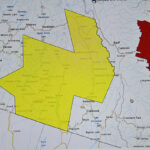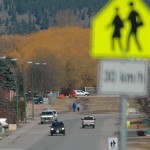Home »

Smoke and heat warnings for most of region
Environment Canada this morning has issued a Smoky Skies Bulletin and a heat warning for Cranbrook/Kimberley, South Country, Columbia Valley Golden and Creston areas. The alerts do not cover Elk Valley and Kootenay National Park but hot temperatures and smoke will be a factor.
These areas will be impacted or likely to be impacted by wildfire smoke over the next 24-48 hours. There is wide-spread haze across large portions of the province which will move with prevailing winds.
“Expect more smoke near active and new fires and for smoke to settle into valleys overnight. Conditions are expected to improve on Tuesday as a change in the weather pattern brings cooler and windier conditions.
Elevated temperatures are expected and there is a moderate risk to public health for East Kootenay, West Kootenay, Kootenay Lake, Arrow Lakes – Slocan Lake, West Columbia, East Columbia.
Hot conditions continue today. Daytime highs reaching the mid 30s with overnight lows in the mid to high teens.
An extended period of high temperatures will continue as a ridge of high pressure remains over the region. Conditions are expected to cool tonight as the ridge weakens. Daytime highs on Tuesday will be noticeably cooler than today.
“The fine particles in wildfire smoke pose the main health risk. As smoke levels increase, health risks increase. People more likely to be impacted by wildfire smoke include seniors, pregnant women and pregnant people, people who smoke, infants and young children, people who work outdoors, people involved in strenuous outdoor exercise and people with an existing illness or chronic health condition. Those who are more likely to be impacted should reduce or reschedule strenuous activities outdoors or seek medical attention if experiencing symptoms,” reported Environment Canada.
“Listen to your body and if you experience symptoms, consider reducing or stopping strenuous outdoor activities. Symptoms can include milder and more common symptoms such as eye, nose and throat irritation, as well as serious but less common symptoms such as chest pains or severe cough. If you think you are having a medical emergency, seek immediate medical assistance. Limit time outdoors. When indoors, keep windows and doors closed as much as possible.
“When there is an extreme heat event occurring with poor air quality, prioritize keeping cool. Always seek out and follow health guidance from local authorities. Protect your indoor air from wildfire smoke. Actions can include using a clean, good quality air filter in your ventilation system and/or a certified portable air purifier that can filter fine particles.
“When spending time outdoors, a well-constructed, well-fitting and properly worn respirator type mask (such as a NIOSH-certified N95 or equivalent respirator) can reduce your exposure to the fine particles in the smoke. Even though exposure may be reduced, there can still be risks to health.
Check in on others who are in your care or live nearby who may be more likely to be impacted by wildfire smoke. Take care of your mental health.
Visit airhealth.ca for information on how to reduce your health risk and your personal contribution to pollution levels, as well as for current and forecast AQHI values. Please continue to monitor alerts and forecasts issued by Environment Canada. Issued by Environment Canada and the B.C. Ministry of Environment and Climate Change Strategy
“Heat affects everyone, but the risks are greater for: seniors, people who live alone, people with pre-existing health conditions such as diabetes, heart disease or respiratory disease, people with mental illness such as schizophrenia, depression, or anxiety, people with substance use disorders, people with limited mobility.
“Check on family, friends and neighbours, who are at higher risk, particularly if they live alone, to make sure they have a cool space. Watch for early signs of heat illness (feeling unwell, fatigue, thirst, headache, unusually dark urine) as these can rapidly evolve into life-threatening emergencies. Move to a cooler environment immediately, such as a shaded or air-conditioned space,” Environment Canada said.
“Drink plenty of water regularly, even before you feel thirsty to decrease your risk of dehydration. Thirst is not a good indicator of dehydration. Never leave susceptible people, particularly children, or pets inside a parked vehicle. If you are in an overheated area, seek a cool place such as a tree-shaded area, splash pad, misting station, or air-conditioned spot like a public building.”
e-KNOW file photo
e-KNOW







